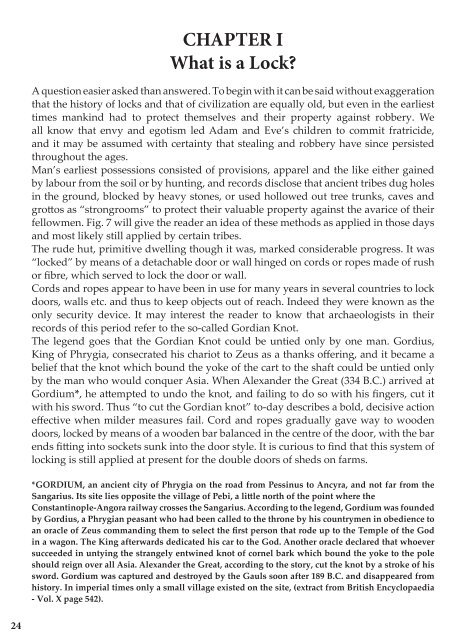Locks and Keys Throughout the Ages
Locks and Keys throughout the Ages is widely considered the best book ever written on the history of locks. It is illustrated throughout with photos from the extensive Lips’ Collection. It was written in 1957 by Vincent J.M. Eras, the director of one of the most respected and important lock manufacturing companies in the world at that time - the Lips’ Safe and Lock Manufacturing Company (now part of the Assa Abloy Group, along with Yale, Chubb, and many others). The author was not only a master locksmith who developed several important patents but he was also an avid collector and was passionate about the history and development of locking mechanisms. His extensive knowledge of the field comes across on every page. In fact, Eras had been in the lock manufacturing business for 58 years before he wrote this book. In the preface he states: “I consider it a gratifying task to place on record my experiences and through this book save them from oblivion. At the same time an excellent opportunity is presented to show the reader my collection of antique and modern locks – the tangible result of more than 50 years travelling, searching and study in many countries”. In over 280 black-and-white photos and drawings Vincent Eras brings us on a grand tour of the development of locks from pre-historic to modern times and he also explains to us, in words and illustrations, how their mechanisms work. This is a high-quality hardcover reprint of the 1957 edition of the book, done by special arrangement with ASSA ABLOY. The typeface has been completely re-done and the photographs have been corrected using the latest digital correction technology. The quality of the photos is equal to and, in many cases, better than the original 1957 edition. A reprint of this book was done in the UK in the 1970s but the quality was poor. Artisan Ideas is very glad to be able to make this exceptional book available to the public again. Hardcover, 184 pages, 284 black-and-white photos and designs, $32.50
Locks and Keys throughout the Ages is widely considered the best book ever written on the history of locks. It is illustrated throughout with photos from the extensive Lips’ Collection.
It was written in 1957 by Vincent J.M. Eras, the director of one of the most respected and important lock manufacturing companies in the world at that time - the Lips’ Safe and Lock Manufacturing Company (now part of the Assa Abloy Group, along with Yale, Chubb, and many others).
The author was not only a master locksmith who developed several important patents but he was also an avid collector and was passionate about the history and development of locking mechanisms. His extensive knowledge of the field comes across on every page. In fact, Eras had been in the lock manufacturing business for 58 years before he wrote this book. In the preface he states:
“I consider it a gratifying task to place on record my experiences and through this book save them from oblivion. At the same time an excellent opportunity is presented to show the reader my collection of antique and modern locks – the tangible result of more than 50 years travelling, searching and study in many countries”.
In over 280 black-and-white photos and drawings Vincent Eras brings us on a grand tour of the development of locks from pre-historic to modern times and he also explains to us, in words and illustrations, how their mechanisms work.
This is a high-quality hardcover reprint of the 1957 edition of the book, done by special arrangement with ASSA ABLOY. The typeface has been completely re-done and the photographs have been corrected using the latest digital correction technology. The quality of the photos is equal to and, in many cases, better than the original 1957 edition. A reprint of this book was done in the UK in the 1970s but the quality was poor.
Artisan Ideas is very glad to be able to make this exceptional book available to the public again.
Hardcover, 184 pages, 284 black-and-white photos and designs, $32.50
- No tags were found...
You also want an ePaper? Increase the reach of your titles
YUMPU automatically turns print PDFs into web optimized ePapers that Google loves.
CHAPTER I<br />
What is a Lock?<br />
A question easier asked than answered. To begin with it can be said without exaggeration<br />
that <strong>the</strong> history of locks <strong>and</strong> that of civilization are equally old, but even in <strong>the</strong> earliest<br />
times mankind had to protect <strong>the</strong>mselves <strong>and</strong> <strong>the</strong>ir property against robbery. We<br />
all know that envy <strong>and</strong> egotism led Adam <strong>and</strong> Eve’s children to commit fratricide,<br />
<strong>and</strong> it may be assumed with certainty that stealing <strong>and</strong> robbery have since persisted<br />
throughout <strong>the</strong> ages.<br />
Man’s earliest possessions consisted of provisions, apparel <strong>and</strong> <strong>the</strong> like ei<strong>the</strong>r gained<br />
by labour from <strong>the</strong> soil or by hunting, <strong>and</strong> records disclose that ancient tribes dug holes<br />
in <strong>the</strong> ground, blocked by heavy stones, or used hollowed out tree trunks, caves <strong>and</strong><br />
grottos as “strongrooms” to protect <strong>the</strong>ir valuable property against <strong>the</strong> avarice of <strong>the</strong>ir<br />
fellowmen. Fig. 7 will give <strong>the</strong> reader an idea of <strong>the</strong>se methods as applied in those days<br />
<strong>and</strong> most likely still applied by certain tribes.<br />
The rude hut, primitive dwelling though it was, marked considerable progress. It was<br />
“locked” by means of a detachable door or wall hinged on cords or ropes made of rush<br />
or fibre, which served to lock <strong>the</strong> door or wall.<br />
Cords <strong>and</strong> ropes appear to have been in use for many years in several countries to lock<br />
doors, walls etc. <strong>and</strong> thus to keep objects out of reach. Indeed <strong>the</strong>y were known as <strong>the</strong><br />
only security device. It may interest <strong>the</strong> reader to know that archaeologists in <strong>the</strong>ir<br />
records of this period refer to <strong>the</strong> so-called Gordian Knot.<br />
The legend goes that <strong>the</strong> Gordian Knot could be untied only by one man. Gordius,<br />
King of Phrygia, consecrated his chariot to Zeus as a thanks offering, <strong>and</strong> it became a<br />
belief that <strong>the</strong> knot which bound <strong>the</strong> yoke of <strong>the</strong> cart to <strong>the</strong> shaft could be untied only<br />
by <strong>the</strong> man who would conquer Asia. When Alex<strong>and</strong>er <strong>the</strong> Great (334 B.C.) arrived at<br />
Gordium*, he attempted to undo <strong>the</strong> knot, <strong>and</strong> failing to do so with his fingers, cut it<br />
with his sword. Thus “to cut <strong>the</strong> Gordian knot” to-day describes a bold, decisive action<br />
effective when milder measures fail. Cord <strong>and</strong> ropes gradually gave way to wooden<br />
doors, locked by means of a wooden bar balanced in <strong>the</strong> centre of <strong>the</strong> door, with <strong>the</strong> bar<br />
ends fitting into sockets sunk into <strong>the</strong> door style. It is curious to find that this system of<br />
locking is still applied at present for <strong>the</strong> double doors of sheds on farms.<br />
*GORDIUM, an ancient city of Phrygia on <strong>the</strong> road from Pessinus to Ancyra, <strong>and</strong> not far from <strong>the</strong><br />
Sangarius. Its site lies opposite <strong>the</strong> village of Pebi, a little north of <strong>the</strong> point where <strong>the</strong><br />
Constantinople-Angora railway crosses <strong>the</strong> Sangarius. According to <strong>the</strong> legend, Gordium was founded<br />
by Gordius, a Phrygian peasant who had been called to <strong>the</strong> throne by his countrymen in obedience to<br />
an oracle of Zeus comm<strong>and</strong>ing <strong>the</strong>m to select <strong>the</strong> first person that rode up to <strong>the</strong> Temple of <strong>the</strong> God<br />
in a wagon. The King afterwards dedicated his car to <strong>the</strong> God. Ano<strong>the</strong>r oracle declared that whoever<br />
succeeded in untying <strong>the</strong> strangely entwined knot of cornel bark which bound <strong>the</strong> yoke to <strong>the</strong> pole<br />
should reign over all Asia. Alex<strong>and</strong>er <strong>the</strong> Great, according to <strong>the</strong> story, cut <strong>the</strong> knot by a stroke of his<br />
sword. Gordium was captured <strong>and</strong> destroyed by <strong>the</strong> Gauls soon after 189 B.C. <strong>and</strong> disappeared from<br />
history. In imperial times only a small village existed on <strong>the</strong> site, (extract from British Encyclopaedia<br />
- Vol. X page 542).<br />
24










